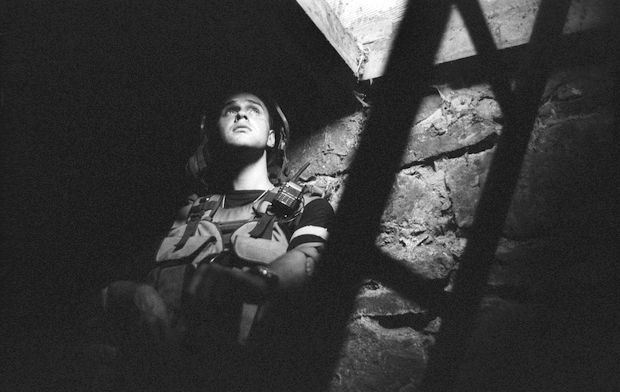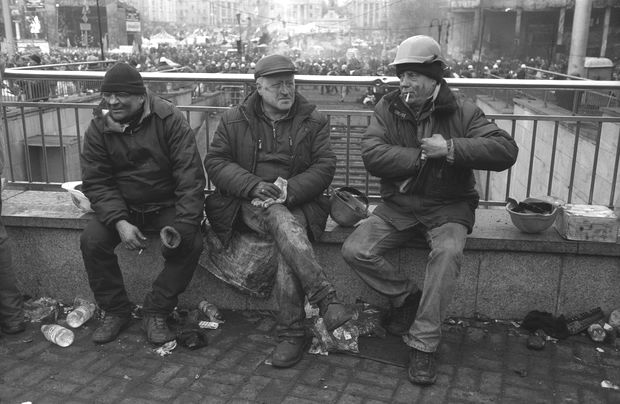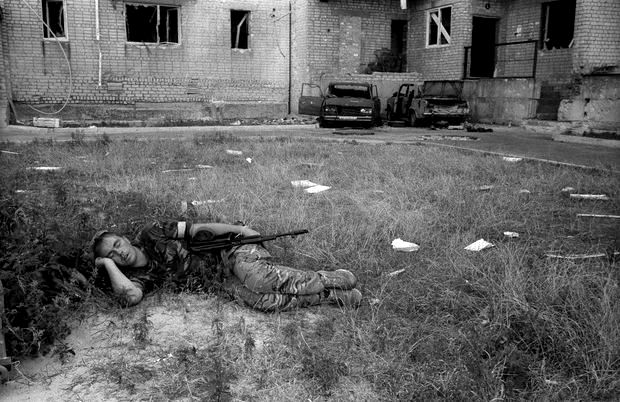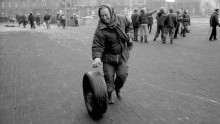Oleksandr Hliadielov is a master of documentary photography. He has worked with humanitarian foundations and international publications, had personal exhibitions in the US, Switzerland, the Czech Republic, Poland, Slovakia, and visited tens of countries. The Hasselblad European Photo Contest Award (Switzerland, 1998) and Mother Jones International Fund for Documentary Photography Award (San Francisco, US, 2001) are among prizes he has won.
Oleksandr photographed on Maidan from the very first day, has been to the frontline with the battalion “Donbas” and was wounded in Ilovaisk. Several exhibitions featuring his photos of the war and the revolution took place in Kyiv during the past few months, and perhaps, those are the best photos of those events.
First of all, we talked about the war.
ILOVAISK
You ended up in Ilovaisk and were wounded there. How did it happen?
“When I sensed there was real war going on in the east, I started looking for opportunities to photograph it. I went there with volunteers once, then I got a permission to go to the ATO zone and joined journalistic tours every day, which were organized by the press service officers. But my specialty is documentary photography, not news, and soon I was fed up with this work, since it is hard to go to places where you need to make photos in order to capture the essence of the ongoing events. In August, Maksym Dondiuk and I joined the battalion ‘Donbas.’ Maksym had a preliminary agreement with battalion commander Semen Semenchenko. He allowed us to photograph. When a reconnaissance group was setting out, we were allowed to join them. Of course, this is an absolutely different approach. We met them once more in Popasna. We spent a night in Lysychansk in a kindergarten, and in Popasna – on the roof of a school building.”

THIS IS AN ARMY SAPPER, A LIEUTENANT. WE ARE HIDING IN A CELLAR FROM MORTAR SHELLING. WE HAD BEEN THERE FOR HALF AN HOUR, MAYBE. LATER HE ESCAPED THE ENCIRCLEMENT NEAR ILOVAISK AND SAVED HIS MEN. A GREAT GUY
Have you been to hot spots before?
“Yes, but not too many times, I am not a military photographer, and now I take photos of the war only because it is happening in my country. A lot of things were not captured on our side, and it is history.”
Were you acquainted with the battalion commander only?
“No, I met friends whom I photographed during peaceful times in Donetsk. We moved to Kurakhove, there were two photographers there who gave us their sleeping spots, since they were going to take a break. From that moment and until the injury, Maksym and I were part of the battalion ‘Donbas’ for about 20 days. During the first assault on Ilovaisk, there were a lot of photographers willing to go and a limited number of seats in a car, so we drew lots and I lost. But I made interesting photos in a different place. On August 18 we entered Ilovaisk, and in the morning of August 21 I was wounded and evacuated to Dnipropetrovsk.”
When did all hell break loose?
“What do you consider to be hell? The war is going on, hell is everywhere. Nearby villages were bombarded by mortars, wandering mortar men with adjusted aim hit the country roads. Close-range street fights were going on in Ilovaisk – it is when people see who they are shooting at, the most complicated type of battle. Also, you might be standing at the crossroads when several mines will be launched in your direction – and that is the war with no confrontation.”
What are the specific features of frontline photography?
“Getting into street fights means creating additional danger for soldiers, because you reveal your location, and if something happens to you, you must be evacuated.”
You work with Leica, and this camera requires short distance between you and the object you are capturing, right?
“Yes.”

FEBRUARY 20 AGAIN. BERKUT RETREATED UP INSTYTUTSKA STREET, PEOPLE GATHERED AND BUILT SOME BARRIERS, AND ARE TAKING A REST AFTERWARDS
So, it means, you had to get close to dangerous places?
“I did not manage to approach the really dangerous ones, I was wounded before it could happen. And it happens that when you end up in a place with intense combat, you will not be able to capture anything, because you need to hide and dodge. When we were in the camp, we were shelled. Later, when Maks Levin got there, it was different, shelling was continuous and harsh, and fights were everywhere.”
A lot is said about Semenchenko. What did you personally see?
“I saw him being seriously wounded. We remained on one side of the bridge, he crossed to the other one and was injured, and four more people with him. Semenchenko got the worst in this explosion. I am personally thankful for him for the opportunity to work and trying to keep journalists away from excessive risks. And his actions in the parliament will show the rest.”
How were you injured?
“In the morning after a relatively calm night, I went outside with everyone else, and there was that school building which was under such precise fire that the splinters would hit the courtyard. It was bombarded from automatic mounted grenade launchers precisely at the moment when men came out, it was done very professionally. This is my second injury, I got the first one in Transnistria, it was a bullet, and this time it was a tiny splinter, it’s still sitting in my leg.”
Did you consider the possibility of being taken prisoner?
“It is a good question. Those who photograph and write were taken prisoners there even before the war. I understood that I must not end up there. When you go to places like that, anything that can happen to a soldier, can happen to you. There is no exceptional position. It would have been real imprisonment, because they manage to track down people’s participation in Maidan. Even your Kyiv residence can be a problem in such case.”
Which moment did you remember as the most dangerous one?
“We went to Mariinka to check several buildings where weapons could have been stored, and after we got on a bus and rode off, four mines hit the spot we were seconds before that. We just set off and heard an explosion behind. Be there were other moments besides this one. We were hiding from mortar shelling in cellars in a village. You learn quite quickly the difference between enemy’s fire and your own. You don’t need to analyze anymore. A lot of people start running right away, if there is a need to retreat. In general, danger is perceived in different ways. There are times when you feel it much more without explosions going off.”

THE PERSON IN THE MIDDLE IS A SLOVAK PRISONER MIROSLAV ROHAC. DURING THE INTERROGATION HE SAID HE WAS FOND OF MILITARY HISTORY AND THAT IS WHY HE WAS THERE. “WHY ARE YOU WEARING A MILITARY UNIFORM?” – “I WOULDN’T HAVE BEEN ALLOWED TO STUDY MILITARY HISTORY OTHERWISE.” – “WHY DID YOU HAVE A GUN?” – “I WOULDN’T HAVE BEEN ALLOWED TO STUDY MILITARY HISTORY OTHERWISE.” – “DID YOU FIRE IT?” – “YES.” – “WHY?” – “I WOULDN’T HAVE BEEN ALLOWED TO STUDY MILITARY HISTORY OTHERWISE.” LATER IT TURNED OUT HE WAS A MORTARMAN. HE WAS TAKEN AWAY BEFORE THE COMPLETE ENCIRCLEMENT. NOW HE IS IN SLOVAKIA, SOME SAY
Were you afraid?
“If a person has no fear at all, it is a problem, including for those who are near him, because you must sense danger. Another thing is being able to cope with fear.”
How?
“There is no point in being afraid once you are in a dangerous place. If you are panicking, standing still there and being afraid, doing nothing will not change the situation. The best way to fight fear is to face it, and act. I have been hiking in the mountains for many years, and dangerous situations happen there too, in which you must act. Fear keeps you from doing what you have come there to do. Unlike the military, no one sent me to the front. Of course, it is scary when you are fired at, but uncertainty is much scarier, when there is a possibility of fire. Well, everyone has been to Maidan.”
By the way, there were volunteers fighting, who had been to Maidan. What do they say about Maidan?
“They say that even the war did not obliterate Maidan for them.”
DIRTY SHADOW
Who do you think is to blame for the Ilovaisk disaster?
“There are things that will remain unchanged during any analysis: not enough forces were used to assault the town and fortify positions in it, reinforcements were expected, but the ones that entered the town were obviously not enough. And of course, the Russian military units, which completely blocked off the territory. The rest is the question of how the command acted, how the subdivisions acted, who was fleeing, who displayed heroism, and also, a lot of confusion. But two points are obvious: the lack of forces and the Russians. In the meantime, there is no real assessment of this defeat, and the culprits at the headquarters, who made the decisions and planned the operations, were never punished. The dirty shadow of unworthy commanders tarnishes the country’s leadership. And until they leave this shadow and the guilty are named and punished, this feeling will persist. Dondiuk and I have understood back there from the victorious headlines on the web that everything is completely different from the way mass media were trying to present it. The common phrase among the men is: ‘If separatists had the same kind of commanders we have, we would have won long ago.’ I think that battalion commanders who were elected to the parliament should push for investigation and punishment of the guilty. This is not the only defeat: think about Amvrosiivka, Savur-Mohyla, who can say now how many men we lost there? If a commander, on whom people’s lives and the fate of the country depend, is not held responsible for the failing results of his actions, how can the army wage the war? Officers who have dignity shoot themselves in such situations.”

THIS SOLDIER’S CODENAME IS ROMEO. HE IS FROM BATTALION “DONBAS.” HE LOST EYESIGHT IN ONE EYE ON MAIDAN (HIT WITH A TRAUMATIC BULLET), WAS WOUNDED IN ILOVAISK, AND WHEN HE WAS EVACUATED, HE RECEIVED ANOTHER INJURY, BUT SURVIVED. IN THIS PHOTO WE ARE IN AVDIIVKA, RESTING, WAITING FOR THE COMMANDER, WHO HAD GONE TO THE DONETSK AIRPORT. THE COMMANDER’S CODENAME WAS TUR (“AUROCHS”). HE DIED DURING THE BREAKOUT FROM THE ILOVAISK ENCIRCLEMENT
This can hardly be expected from our generals.
“We will never know how many men decided to blow up themselves in order to avoid captivity. On August 20, when the wounded were taken away out of battalion ‘Donbas,’ we were ambushed, and those who could walk had to leave the car. There was one heavily-wounded soldier, who was already non-transportable at the time, he blew himself up with a grenade, when separatists approached the car. The rest survived because he did it.”
NOTHING FOREBODE THE TROUBLE
Had you been to Donetsk before?
“A year ago, in September, I was taking photos of how doctors treat tuberculosis in Penal Colony No. 3 in Donetsk oblast, and before that I worked at two large exhibition projects: about the national network of patients with HIV in Donetsk and Makiivka, and about HIV-positive women, who were not destroyed by the diagnosis, and had successful family life and careers.”
Do you think what is going on there now was inevitable?
“It always seemed that we were lucky to escape what affected others. It turns out we weren’t, and few can measure up to our bad luck. I always talked to people, and I have never had a feeling that something of this kind would happen. Last September an office worker in Donetsk told me: ‘You think that all of us here are some Russian flag-wavers, but if an independent opinion poll was carried out, I’m sure that more than 60 percent would support Europe.’ Local drivers stood nearby and nodded consent. And when I came to shoot soon after the elections of 2012, no one admitted they voted for Yanukovych. Perhaps, I just came across such people.”
It is scary to even think how those HIV-positive patients are doing there now.
“Medications are sent through somehow, but I do not know if it is done regularly. Supplies required for treating fresh injuries are usually sent there, but there are people with grave illnesses which require constant medical support. Of course, they are not doing good.”
Do you miss the frontline?
“I do not have problems that require psychologists’ correction. And a lot of people had a post-traumatic syndrome after Maidan. But I want to see those guys I was there with. In this respect, your question is precise. I miss the frontline as the place to be, if you want to be able to tell the truth about it. This is a very serious reason.”
Do you keep in contact now?
“I meet with them here. Guys came over here a couple of times already: to look at the photos or just chat.”
IT IS IMPOSSIBLE TO BE INDIFFERENT
Is military photography different from other documentary genres?
“I would not call it military. There are reporters who specialize in it. I am not one of them, it just happened that I have been to such places a couple of times. I think it is necessary: if you do not do it, no one will know what happened and how it happened, what these people looked like. At first they might refuse being photographed, but then they look through the photos, wondering if they are in any of them. Photos must be made at least for the sake of memories. I receive a lot of phone calls. The 93rd Company had huge losses, and I have a lot of photos of those guys, for friends and family. Also, it is a matter of our common history. There is no pompousness about it. Government archives must be made.”
Maidan and the war have been photographed by thousands of people, including amateurs. Can a mass flow of these images change the language of photography?
“I would put it differently. It is not the matter of turning quantity into quality. There were those who could capture really good shots on Maidan, and even more of those, who took photos with any means they had. Besides, we now see the images of war created by its participants, they are doing what professionals should be doing. So, no one has made any efforts so far to gather and systematize this material, even in the more available areas, if we talk about Maidan. It would be nice if an archive was created. But it is not only the issue of lack of initiative, people who would do it would have already been found in peace time. Now the priorities are different.”
And how did you change?
“I don’t know if I can talk about changes. If we talk about involvement, yes, there were some deep notches, if I can put it like that. It is impossible to be indifferent on Maidan or at war. You perceive everything more sharply. My attitude towards the land and the people has become deeper and more precise. When I was photographing Maidan, for example, I was not sure whether it would look decent, and whether I would not be ashamed of what I was doing. Then I managed to select photos I can exhibit with a clear conscience. And in case of the war, there is a feeling that so many more photos must be made to be able to say something.”








